The Complete Guide to Hiking the Narrows in Zion (Gear, Permits, Tips, and more!)
This post may contain affiliate links.
Is the Narrows hike in Zion National Park on your bucket list? With an exciting trail that follows the curves of the Virgin River and takes you between narrow canyon walls reaching 1,500 feet tall, it should be! In this guide, we’ll walk you through everything you need to know about hiking in the Narrows so you can start planning your trip.
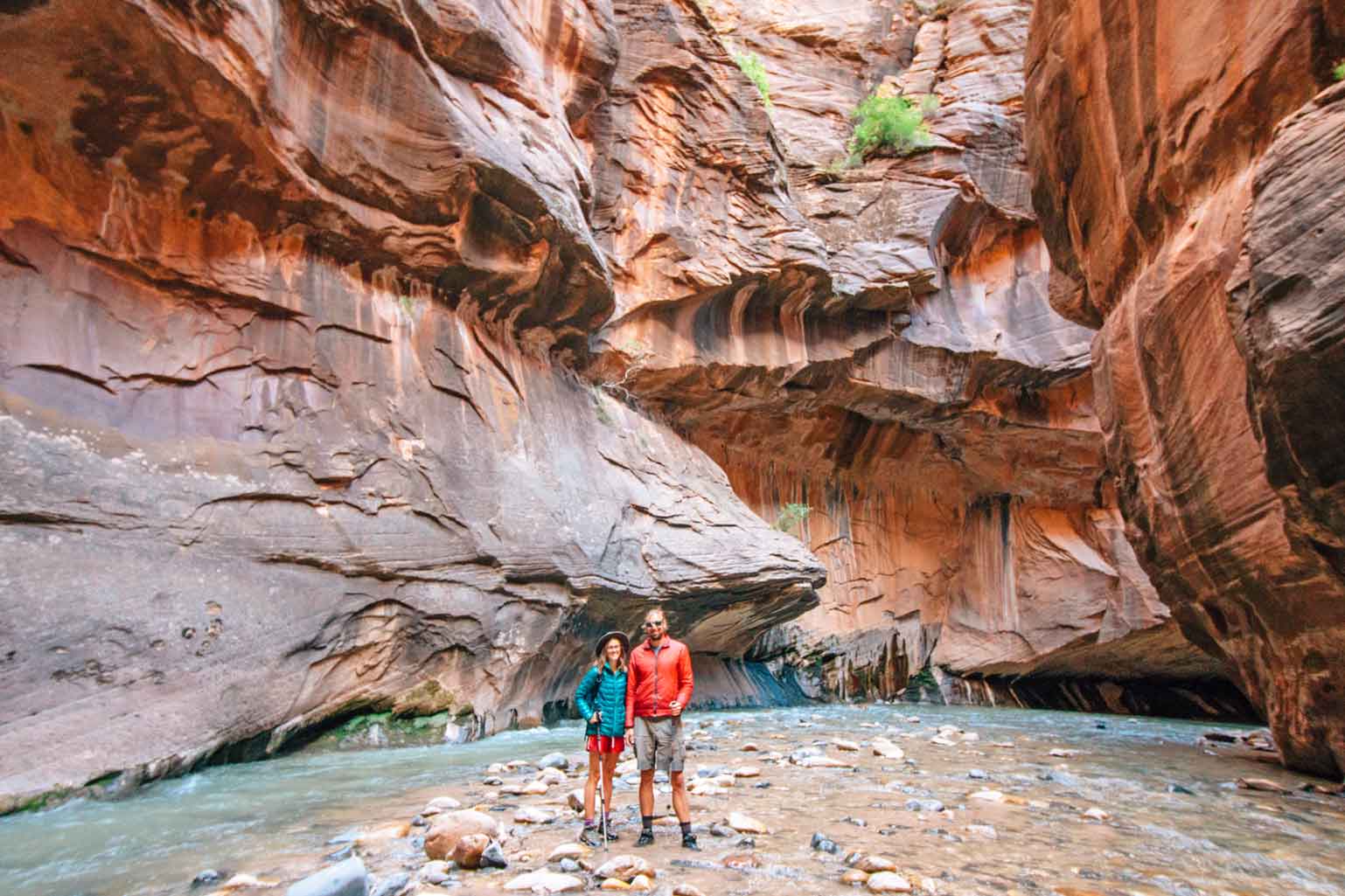
The Narrows is one of the best hikes in Zion National Park. Formed over millions of years and shaped by the erosive forces of the Virgin River, the trailhead starts towards the back of the main Zion Canyon, where the river flows between the towering canyon walls.
There’s not much room for an actual trail, so for much of the hike, you’ll forge your own path through the river as you wander through this epic slot canyon.
In this guide to hiking the Zion Narrows, we’ll cover everything you need to know about this unique hike, including the different routes, the permit process, essential gear, and tips on staying safe during your trip.
Quick tips for hiking the Narrows
- Hiking from the bottom up is best for beginners and families (and you don’t need a permit!)
- Late spring and early fall are the best times of year to hike the Narrows
- Start early to avoid heat and crowds
- Budget 1-6 hours to hike the bottom-up route, depending on how far you want to hike
- Wear the right kind of shoes and bring a walking stick or hiking poles
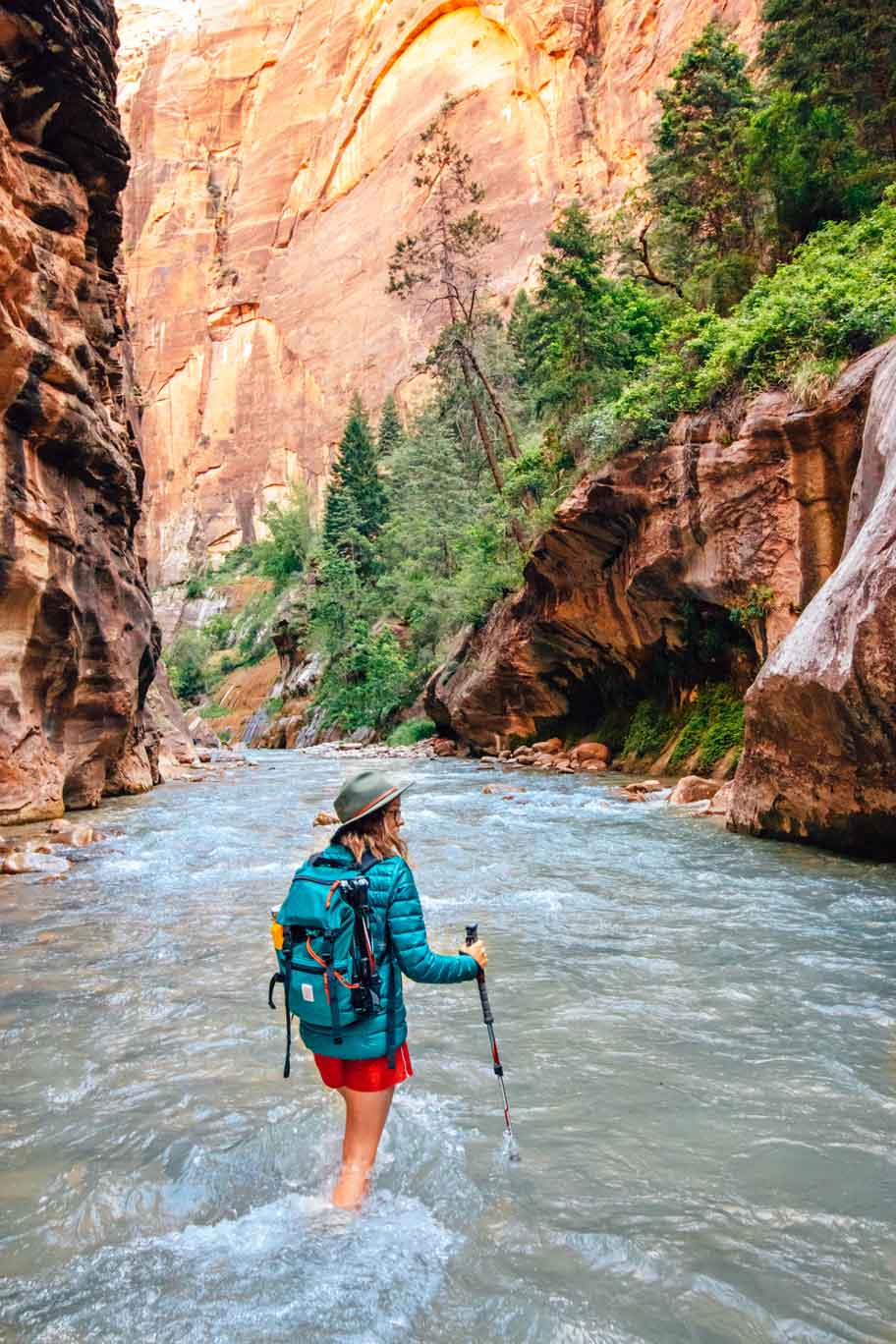
Planning your Zion Narrows hike
If you plan to hike the Narrows during your visit to Zion National Park, you’ll want to consider which route to take, know what to expect during different seasons, and make sure you have the right gear. In this section, we’ll go into all the details!
Route options & permits
There are three routes to choose from. Here’s a brief overview of each (you can read more details about the routes in these sections).
Bottom-up day hike
This is the most popular way to hike the Narrows. This route begins at the Temple of Sinawava, accessible by the Zion Canyon Shuttle, and does not require a permit. You can venture as far as Big Spring before turning back, covering a total distance of about 10 miles round trip. This option allows hikers to explore the Narrows without dealing with complicated logistics or committing to a full-day or overnight backpacking trip.
Top-down overnight hike (permit required)
This is a more challenging, 16-mile route hiked over the course of two half days. You’ll start at Chamberlain’s Ranch (located outside the park) and trek through the entire length of the Narrows, ending at the Temple of Sinawava. This option offers a more immersive experience and includes camping in designated sites within the canyon.
Top-down day hike (permit required)
A top-down, single-day hike is the most challenging way to hike the Narrows. The average time it takes to hike this 16-mile route is 12 hours. For this hike to be feasible, you’ll need to be a very strong hiker and have enough daylight hours during your visit to complete the hike.
How to obtain your permit
There are two steps for obtaining your permit to hike the Narrows top-down:
1) securing an advanced reservation online, and
2) purchasing the actual permit at the visitors center before your hike.
Reservations for top-down permits open at 10 am (Mountain Time) on the 5th of the month for hikes the following month. Sound confusing? Here’s how that timing works out:
| For a trip in… | Online reservations open at 10 am MT on: |
| January | December 5th |
| February | January 5th |
| March | February 5th |
| April | March 5th |
| May | April 5th |
| June | May 5th |
| July | June 5th |
| August | July 5th |
| September | August 5th |
| October | September 5th |
| November | October 5th |
| December | November 5th |
To reserve a top-down backpacking permit, go to this page on the National Park Service website, choose your group size, and then choose your site number and date from the availability calendar (the numbers correspond to these campsites). Then log in to pay the $5 reservation fee.
To reserve a top-down day hiking permit, go to this page on the National Park Service website and select “Virgin Narrows Day Use Trail From Top” from the drop-down menu under “Available Permits” and your group size. The availability calendar will update, then you can make your date selection and log in to pay the $5 reservation fee.
To pick up and purchase your permit, head to the visitors center the day before your hike or the day of your hike. The visitors center is usually open 8am-5pm (double check here), so if you plan to get an early start, go the day before. The person listed as the reservation holder must pick up the permit in person at the Visitor Center Wilderness Desk and pay the permit fee (this is in addition to the reservation fee already paid): $15.00 for 1 to 2 people, $20.00 for 3 to 7 people, or $25.00 for 8 to 12 people.
What if I couldn’t reserve a permit online?
There are a few options if you weren’t able to reserve an advance permit online. The easiest, of course, is to hike the Narrows bottom-up, which doesn’t require a permit.
Only half of the backpacking permits are available in advance, leaving the others available the day before on a first come, first served, walk-in basis.
For top-down day hikes, you can apply for the Canyoneering Daily Lottery for any open reservations. The application opens 2 days before the hike date at 12am (midnight) MT and closes at 3pm MT. They’ll email you the results at 4pm MT.
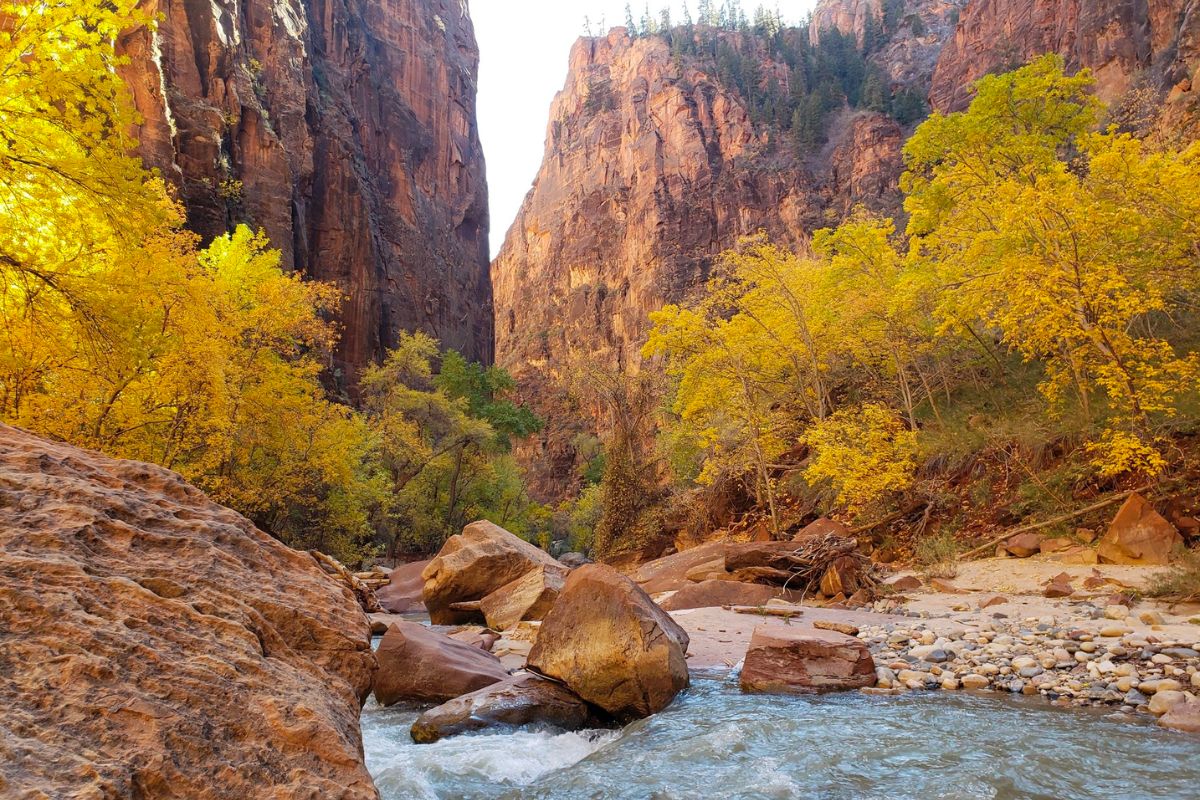
Best time to hike the Narrows
Summer: Zion sees increased visitation from June through September, so this is the most popular time to hike the Narrows, but it’s also the most crowded. July-September has the highest flash flood potential. However, this is also when the water and air temperatures are warmest, so you likely will not need to rent special gear like dry pants/suits.
Fall: The end of September and October are widely considered the best times to hike the Narrows. Water levels are lower, there is a reduced risk of floods, and crowds are thinner. However, temps are starting to drop.
Winter: This time of year is downright cold (hypothermia is a real risk), but it is possible to hike with the right gear. The water levels and flood danger are typically low.
Spring: The Narrows are often closed for much of April and sometimes into May due to high water levels. However, if the water is right, the latter part of May is a great time to hike (this is when we did it).
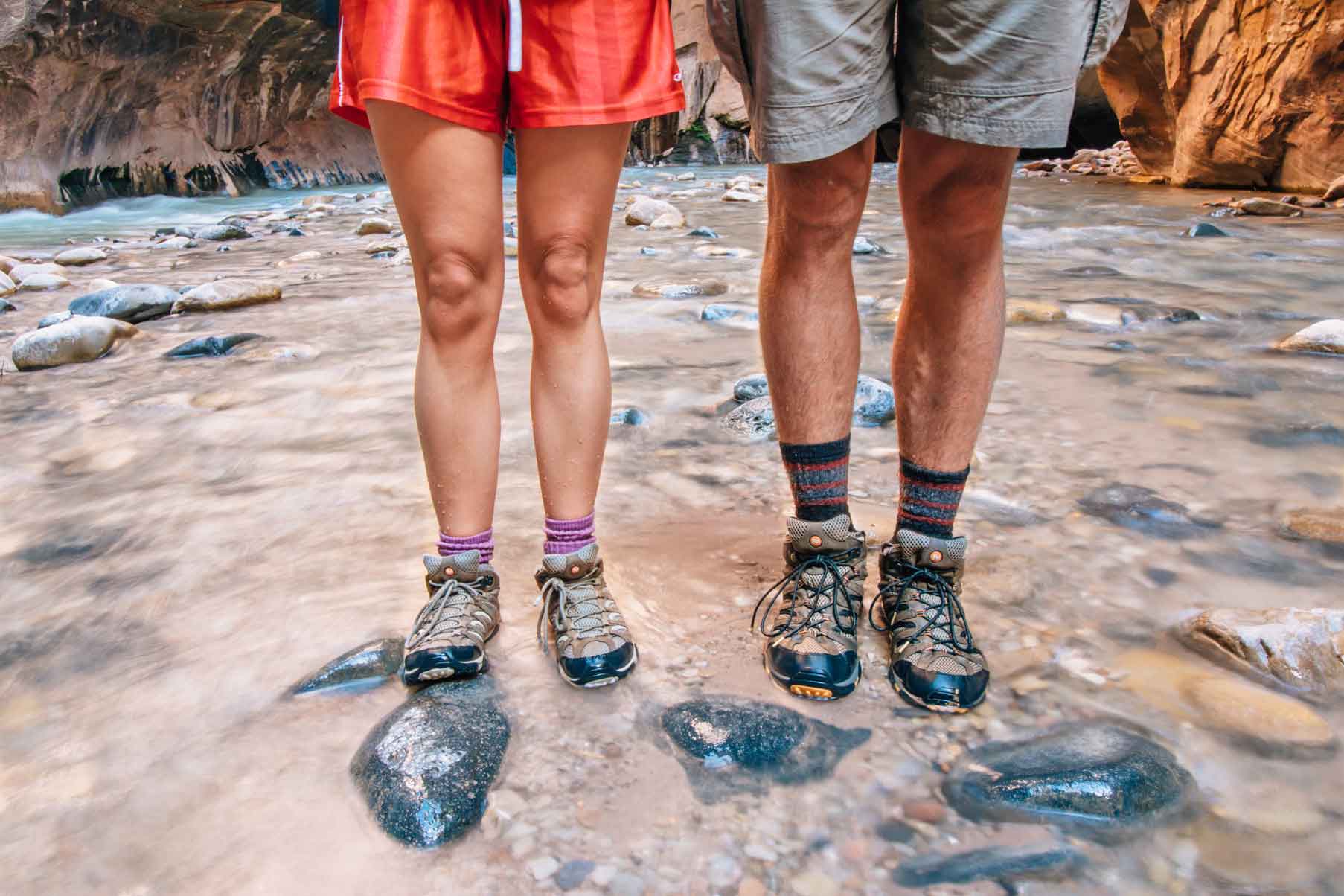
Essential gear to hike the Zion Narrows
In preparation for this hike, many people decide to rent specialized gear like canyoneering shoes, neoprene socks, walking sticks, waterproof pants, and even full zip-up dry suits. While this gear can be absolutely essential during winter and early spring, it can be a little overkill during the warmer summer months. In the summer and early fall, when the water is warm, it is possible to hike the Narrows with the basic hiking equipment you probably already own:
Footwear: Since much of the hike is spent walking in a river with varying-sized rocks, you’ll want to wear closed-toe shoes with sturdy, grippy soles. Leave your Tevas, Chacos, flip flops, and soft water shoes behind and opt for a pair of trail runners or light hiking boots, ideally with a Vibram sole. Alternatively, you can rent canyoneering boots, which are designed to provide a solid grip when hiking in water.
Socks: Wet socks and shoes can be a recipe for blisters, which is why many people opt to wear neoprene socks, which fit snugly to avoid rubbing against your wet skin. We personally wore wool socks with our light hiking boots during our hike and didn’t experience any blisters.
Clothing: Our biggest tip here is to wear layers! Start with a lightweight and quick-drying synthetic top and bottoms (avoid cotton). Pack a synthetic insulating jacket in a dry bag—even in summer. In colder months, you may also want to bring a fleece mid-layer.
Hiking stick/poles: The most common rental you’ll see when hiking the Narrows is a classic wooden walking stick. The fast current and uneven riverbed can make it a challenge to maintain your footing, so having a way to support yourself can prevent a tumble into the water. We used our trekking poles and they worked just fine.
Dry bags and waterproofing: A waterproof dry bag will keep your electronics safe in the event you do end up in the water. It’s also a good idea to store your warm layers in a dry bag when you’re not wearing them.
Water: You need to carry all the water you need for your hike. Because of the presence of cyanobacteria, there is no way to treat the water to make it safe to drink from the river.
Rental options in Springdale
In cooler months, you may need to rent specialized gear to safely hike the Narrows. These are some of the items that can be rented for your hike:
Footwear Package: Most gear outfitters offer a package that includes canyoneering shoes, neoprene socks, and a walking stick. These items are helpful any time of year, helping to provide solid footing and stability when walking on the rocks in the river. The neoprene socks help insulate your feet and prevent blisters.
Dry pants: During the cooler fall and spring months, dry pants will help keep your legs warm and dry.
Dry bibs: If you’re likely to encounter sections of the hike with water levels at or above your waist, opt for a dry bib.
Waterproof bags/dry sack: For clothing and camera gear.
Here are the most popular and highest-rated gear rental shops near Zion:
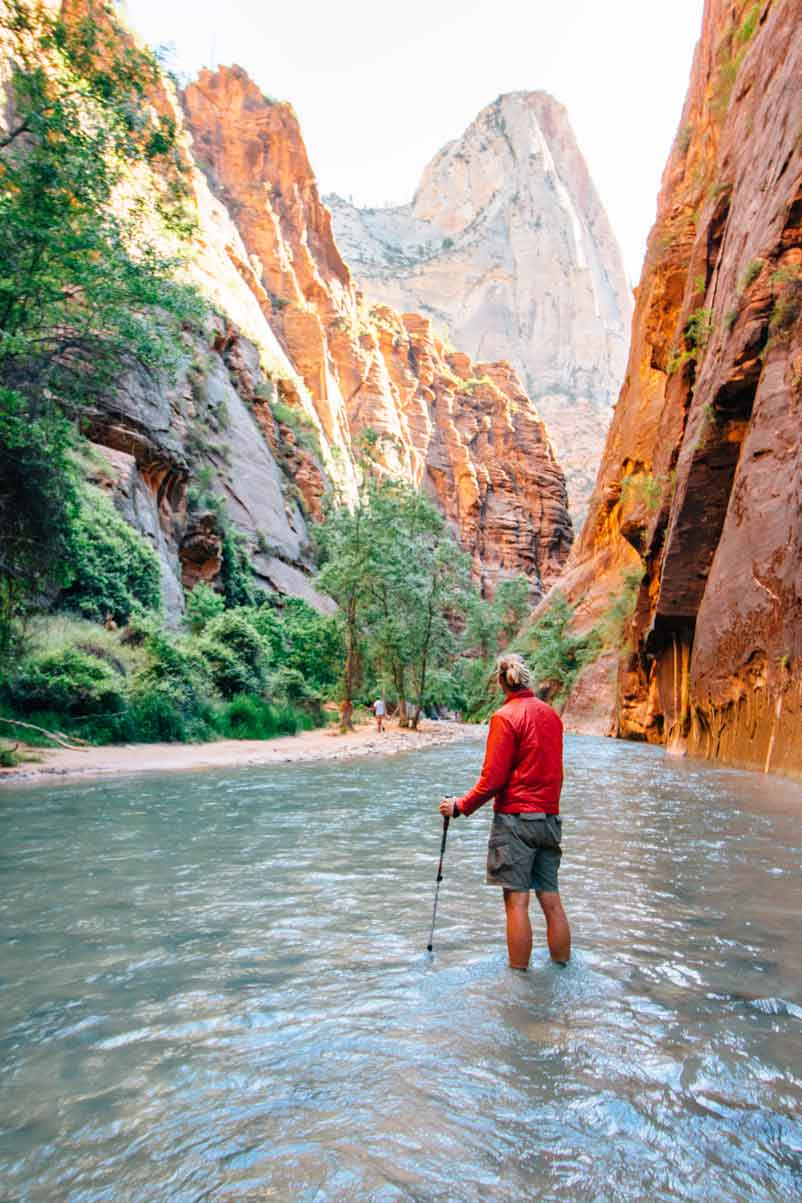
What to expect on a bottom-up day hike
Length and difficulty level
The Narrows hike can be as short as two miles round trip along the Riverwalk, up to 10 miles to go all the way to Big Springs and back. It all depends on how long you want to hike.
The difficulty of the hike depends primarily on the current water flow rate in the canyon (measured in cubic feet per second, or CFS). As the CFS increases, so does the speed and height of the water.
A CFS rate of 0-60 makes for an easier hike, 60-90 is moderately difficult, and rates of 90+ are increasingly challenging (and not suitable for smaller children). If the CFS passes 150, the park service will close the Narrows.
Here, you can see a graph of the current flow rate:

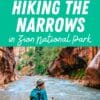
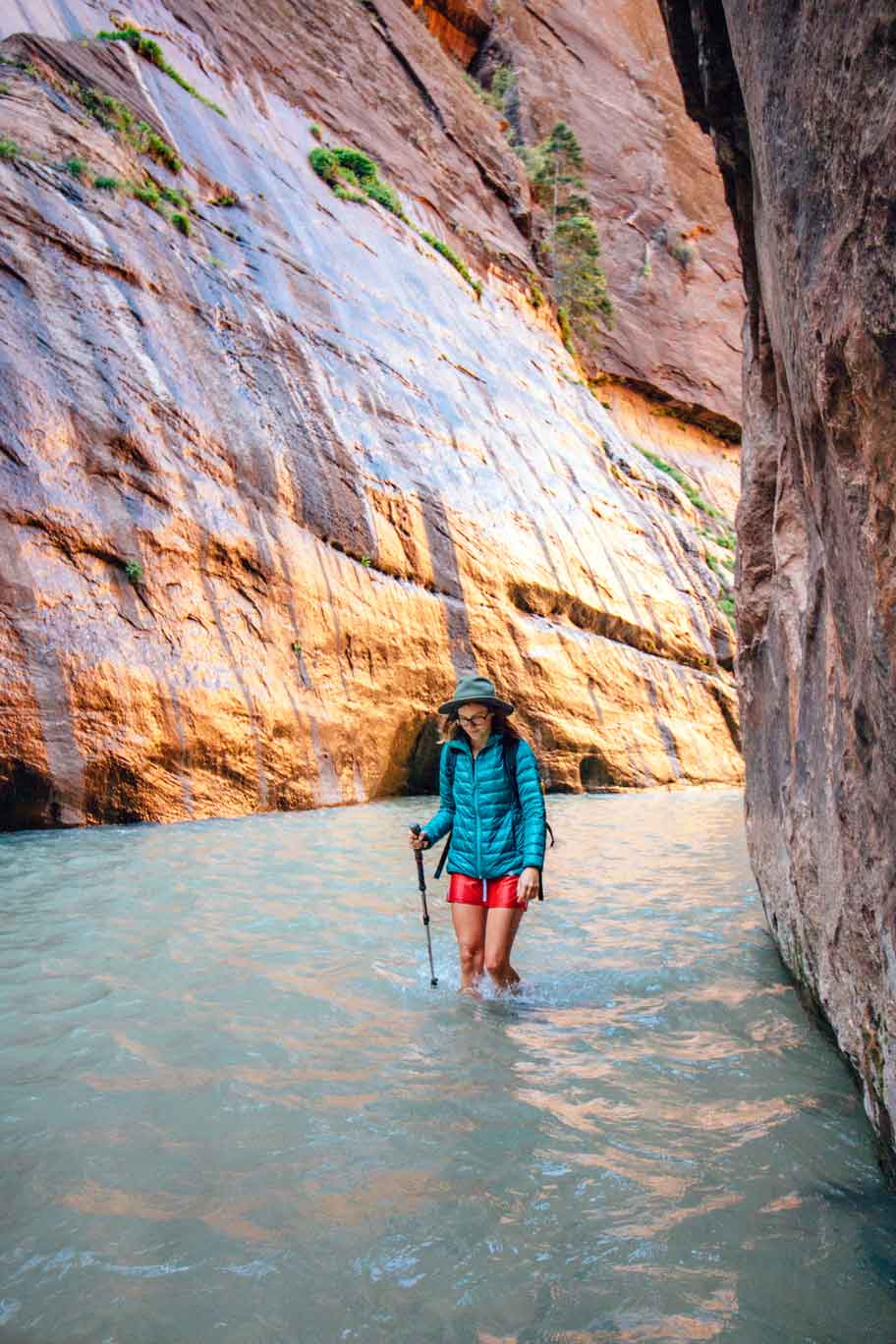
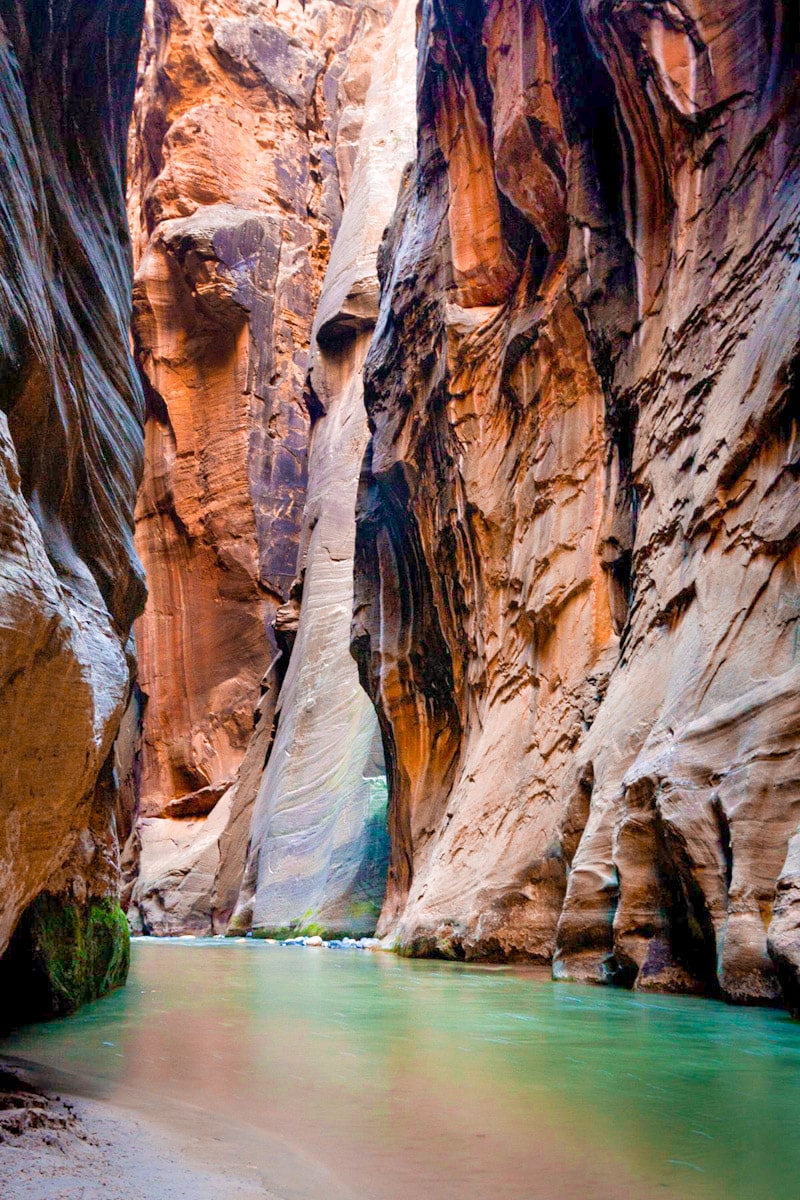
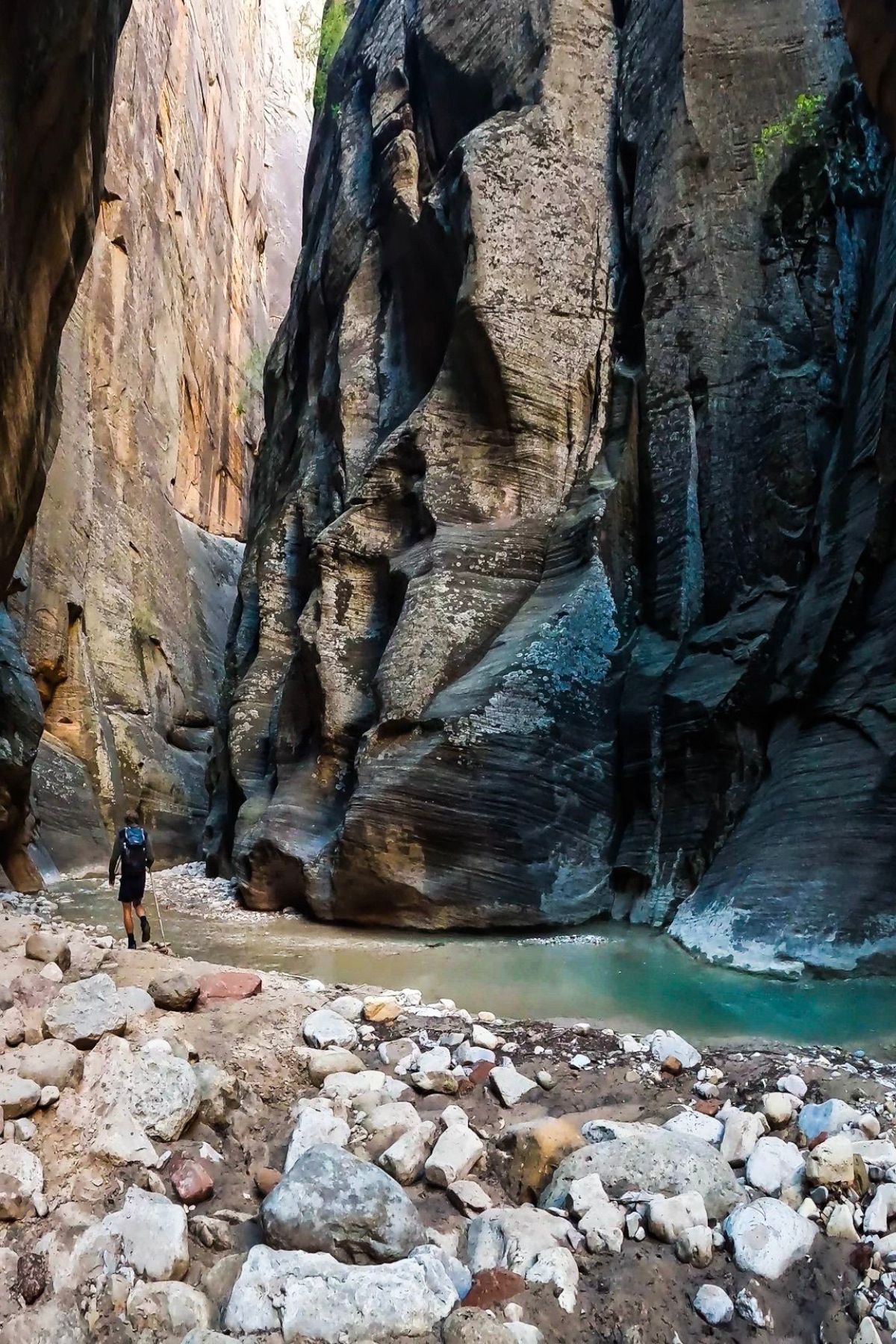
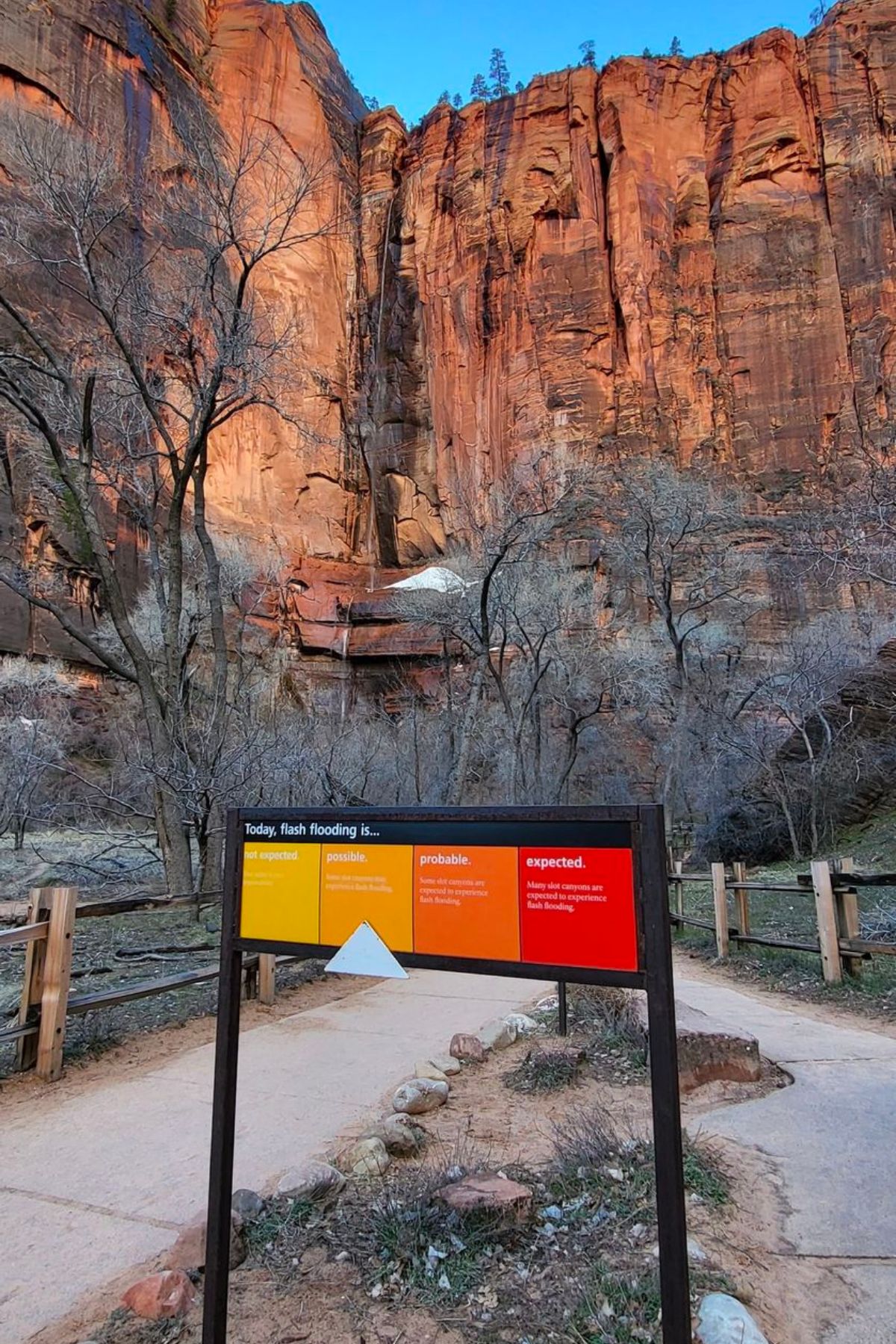
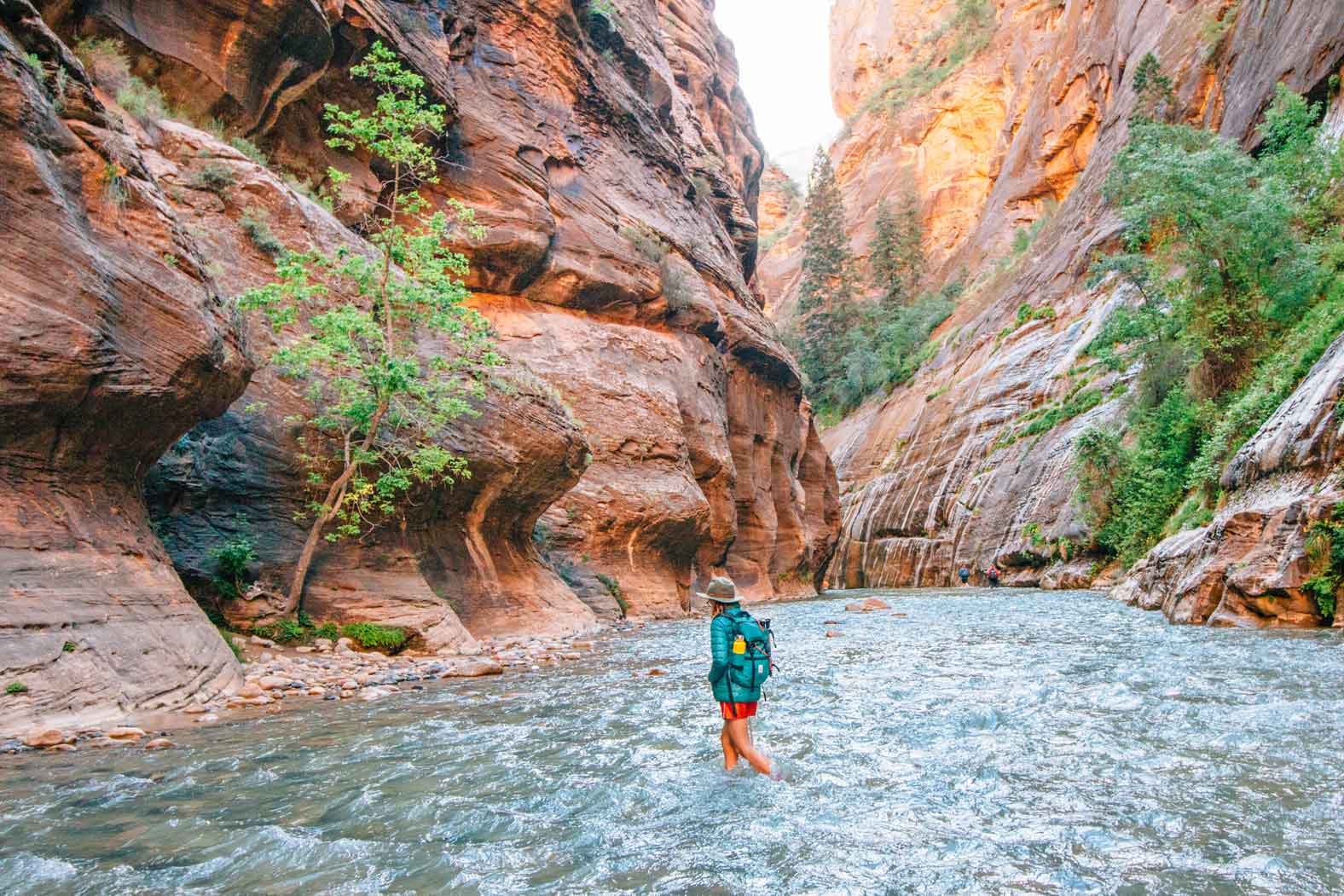
Thank you for this post!! My boyfriend and I took your advice and hiked it with our own gear and everything worked out wonderfully! We didn’t have trekking poles, but there were some “natural” poles at the start of the hike that we were able to use. I wish we would have thrown some flip-flops into our backpack for the paved part of the walk back to the shuttle, but no complaints from us… this hike was magical!! You also feel just a little more bad ass when you’re not using the same gear as everyone else 🙂
Glad to hear you enjoyed your hike, Michelle! The Narrows really are such a special place.
I agree that any ole pole would work – it’s just nice to have something to help balance when it’s rocky or the current wants to push you around.
You’re totally right about the flip flops!! We also walked back in soggy shoes but it would have been nice to have our Chacos to change into.
This sounds great! My boyfriend and I are planning a trip for next year and we will definitely follow your advice! BTW, what time in the year did you guys go?
Hi Fabbiola – we did this hike in late May. The conditions definitely fluctuate throughout the seasons though. Have a great time on your trip!
I see your wearing hiking boots, thru the water? What kind are the best? We are thinking of going next summer.
Kristie – we did use our hiking boots, but they are very lightweight and meshy, so they dry out pretty quickly. I wouldn’t recommend heavy duty boots since they would likely get pretty heavy when wet. We currently both wear Merrell Moab Ventilator boots, but prior to those we had a pair of lightweight boots by Vasque that were also excellent.
All that you’ve said is sufficient for hiking from the bottom up to the spring. I’ll only add:
1. It’s always advisable to have poles or a walking stick (preferably a walking stick, poles are known to break) for leverage. Need fluctuates with water level but I’d still take something.
2. Wear a minimum of .5mm neoprene socks with thin merino wool socks underneath even in summer. Even if you’re going to wear hiking boots/shoes this is the best combo for staying warm. Wool retains heat even when wet and protects you from rubbing against seams in the neoprene sock. Do NOT wear cotton. Do NOT wear open toe anything.
3. Don’t wear anything cotton. Take only synthetic clothes.
4. Please understand that hiking down from the TOP of the narrows (16 miles) is much much different than from the bottom and requires much more gear and corners cannot be cut.
Just wanted to confirm what Brian said. If you’re hiking from the bottom up, it is very easy to do using gear you already have. I’ve done this many times on spur-of-the-moment trips to Zion (I’m a Utah local). HOWEVER, if you are planning on hiking from the top down, plan carefully and do not cut corners. It’s a long trip and completely miserable–and dangerous–if you don’t have the proper gear for the conditions.
We’re getting ready for our sixth trip down as I type, and I can attest that a sturdy walking stick is vital bottom up or top down. Those ugly yellow boots that everyone laughs at? We’ve found them to be very valuable equipment when hiking the full 16 miles top down over what feels like moss covered bowling balls with a fully loaded pack.
Hello, we are planning a trip to Zion Park on mid September, what can you tell me about the average temperature and water conditions.
And what would be the best hike rout for a forts time hikers couple.
Thank you!
hello stacy
we are going first time to utah and i just wanted to have expirance( first water hiking) of
hike in the narrows. is there a way we can go half way and come back?
also you said from bottom to up is little easy for beginners or first timer?
what kind of yellow boots are good to buy?
thanks
Hi Brian,
We are planning to do the Narrows on mid September and hike from the top to bottom.
Why is this hike more difficult than going from bottom to Top?
Or did I misunderstood?
Just finished a top-down Narrows backpacking trip. Temperatures were 70s and sunny but our group of three all hiked in our normal backpacking boots and wool socks. We are Alaskans and are used to “hiking wet” in cool temperatures, but I’d imagine there are plenty of folks out there who would feel the same way. Another person on our shuttle was also wearing normal socks and hiking shoes too and he also did just fine.
I hiked in a cotton shirt. Cotton is great at keeping you cool, which can be super helpful in hot temps. Of course, full synthetics are much better at keeping you warm when wet. I was glad to have a warm fleece coat, which I wore when the sun got low.
If anything, I would steer people away from bring down for mid-layer active insulation in the Narrows. Down in a drybag for camp is great, but down is basically worthless if it gets wet. Cotton to stay cool, synthetics/fleece to stay warm, down for camp if needed.
Hello, Thinking of purchasing those hiking boots for an upcoming trip to Zion. How fast did they dry out after? Were they dry for hiking the next day? Thanks so much for these tips. We’re going in October and trying to decide which new equipment to purchase.
Those Moab Ventilators dry out pretty quick. Depends on how hot it is, of course. But if you hike the narrows in the morning and then let them dry out all day, they should be good for another hike the next day.
good to know. thank you! getting excited for our trip! just bought the Moab ventilators and the are so comfortable!
Hi! My boyfriend and I are going the first weekend in November to Zion just for the weekend and planning on hiking Angels Landing the first day, then trying the Narrows on the second day. Obviously depending on how chilly it actually is we may not be able to do the Narrows. I have a few questions: how cold is too cold to try the Narrows? and even if one couldn’t do an actual hike is there still dry ground you can walk on to at least see part of it? I am also a first time Hiker, I am fairly athletic, but are either of these two trails dangerous for someone who has little experience? Any insight is greatly appreciated!
November might be too cold to hike the narrows without specialty equipment (waterproof booties, neoprene pants, etc) Check with the gear shops in Springdale when you arrive as they will have a good idea how cold the river is running. As for being a first-time hiker, Angel’s Landing is a pretty tough one to start on. Especially if there is any snow on the trail. A portion of the trail runs along a narrow ridgeline with thousand foot drops off each side. So any lack of traction can be something to worry about. Ask when you get there what the conditions are like. Otherwise, we have a list of other great hikes in the area. https://www.freshoffthegrid.com/4-hikes-beat-crowds-zion-national-park/
I’m planning a trip to explore Utah this summer (June) and the Narrows is on my list. I will be hiking with my 2 young boys- ages 7 and 6. They are both good hikers – 5mi in the snow at yellowstone, Volksmarch at Crazy Horse. They don’t mind getting wet at all. I’m wondering though if the current may be too strong for them? My 6 year old is easy to piggy back but the 7 year old is on his own. Thoughts on kids in the Narrows? We won’t be hiking the entire route.
Honestly, it all depends on the day. During the time we stayed in Zion, the river’s levels fluctuated constantly. Some days would be a piece of cake for your two boys, others could be a bit hairy. Check with the park rangers and they can give you monthly averages, but you’ll need to make game day decision when you’re there.
So I own Chacos and have used them to treck across waterfalls, climb slippery rocks, and walk through rivers in Belize. Do you think they would be fine for the narrows? They have enough traction for sure
Grip-wise they will be fine. Two concerns would be: toe protect and water temperature. You’ll be stepping around on a lot of underwater features and in a few sections, the water current doesn’t give you a lot of visibility. It might be nice to have something covering your toes so you don’t accidentally stub them into a rock. In the height of summer, the water temp will still be pretty cool but probably manageable in Chacos. While the boots we used obviously got soaking wet, our wool socks did act like a semi wetsuit for our feet (keeping warmer water trapped near our feet).
My husband hiked the narrows. He’s 6’2” tall and was up to his shoulders in water!
Gloria,
What time of year did your husband hike the narrows?
Do i need to contact a special guide to hike through the narrows, im going with a group of 13
Hi Maria,
I’m unsure of the national park’s policies regarding large groups. Would probably be best to contact the park directly: https://www.nps.gov/zion/index.htm
Enjoy your trip!
Were your boots water proof?
No, we did not have waterproof boots. We just embraced the fact that they were going to get wet. Not a problem in the summer, but more of an issue later in the season.
Great advice. I’m thinking of heading to Zion this weekend. How early did you start the hike to beat the crowds?
We got in as early as we could. I forget the actual time, but as early as possible. I think we were on the first round of shuttles that went into the park.
My wife rented the boots and pole. She loved it. She didn’t complain about her feet. I went with Salomon hiking boots for $139 before we left for the trip. They worked great but got small stones inside. I had to take them off to empty out the stones. She did not have to with the rented boots that strap tight to your ankle. Doing it again, I would rent the boots and walking stick.
This article really helped us. We were prepared to rent if need be, but our conversation with the Rangers confirmed our feeling that we could use our own gear, which we did. We are in our late 60s and always hike with poles, so having 2 poles, vs. the one that is rented, was really useful. The river was cold, but not as icy as others have written (we hiked on 7/2/21). We used our own boots, wool socks, and yes of course our feet were wet, but not terribly cold.
We were in the water by 6:45AM, along with some people but maybe only 50-75. We hiked in about 1.8 miles and on our way back, we think we saw 1000 people, many ill-prepared. So everything you’ve read about crowded national parks is true.
Fabulous hike though. Was quite cool in the canyon b/c we left before the sun was overhead. Unforgettable experience. Water levels were moderate. I’m 5’3″ and the water was up to my waist for @ 5 minutes, but mostly was shin/knee height.
Enjoy!!
No mention of the bacteria problem in the water. The Narrows hike was temporarily closed because of this so it would be good to check with the headquarters. We hiked in November 2019 and dry pants, neoprene socks, and canyoneering boots were essential! Awesome experience!
We are going next week, current water temp is 56 degrees. I am really a freeze baby – I wear a dive skin when dining in the Caribbean with 86 degree water temps. I’m considering wearing my skin for the Narrows, would that be overkill for someone like me? Thank you!